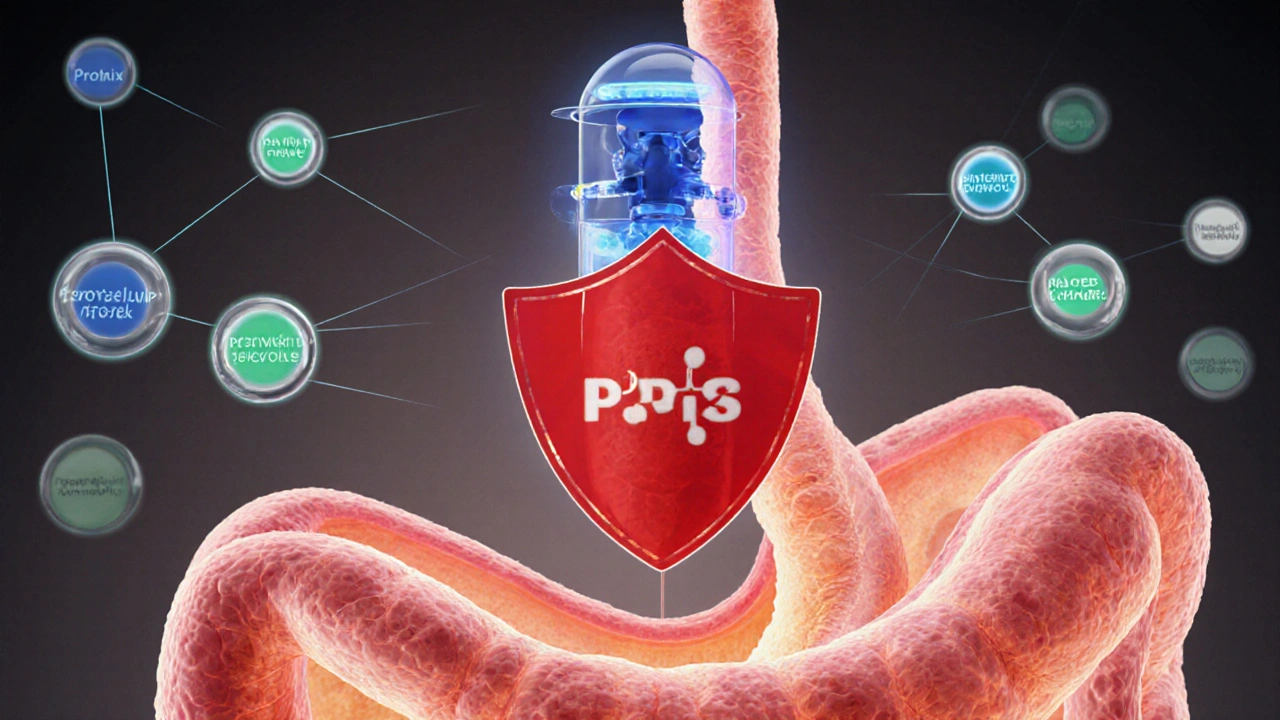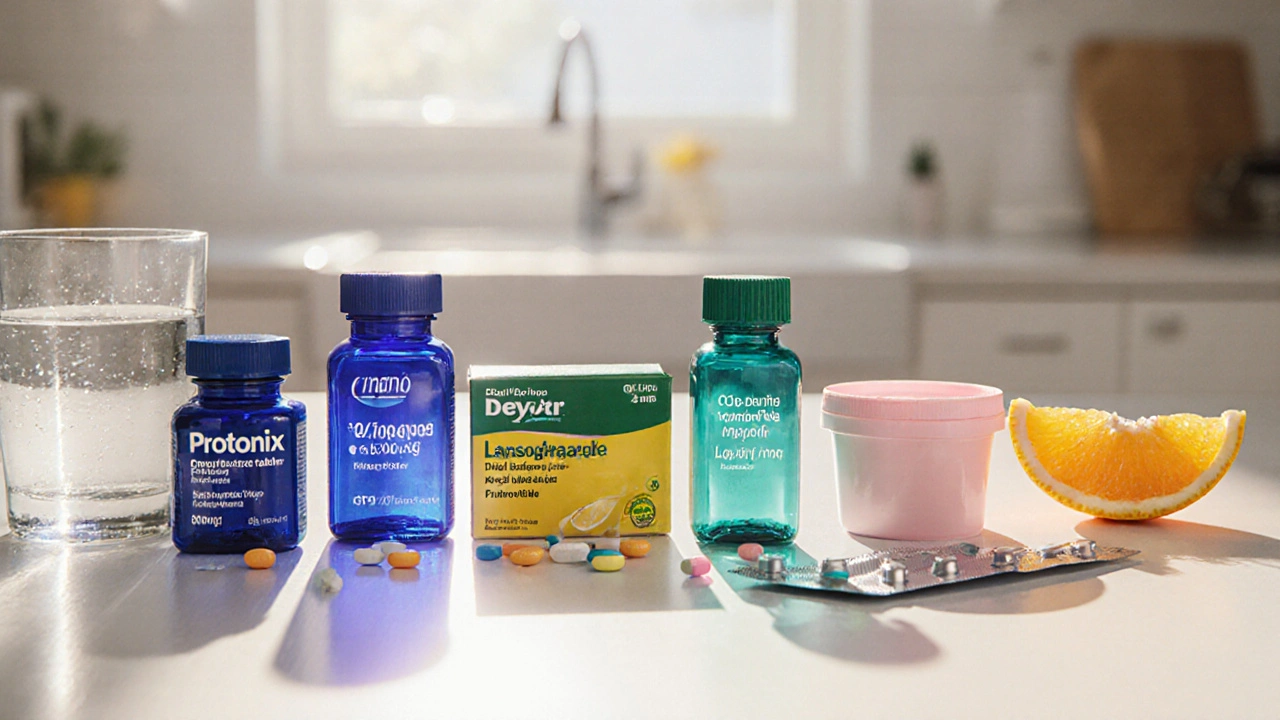Protonix vs Alternatives Comparison Tool
Protonix
Brand-name PPI with proven efficacy for moderate-to-severe GERD
Omeprazole
Over-the-counter alternative, cost-effective option
Lansoprazole
Another OTC PPI with similar effectiveness
Dexlansoprazole
Dual-release formulation for better nighttime symptom relief
Famotidine
H2 blocker for occasional heartburn
Antacids
Quick relief for mild symptoms
Comparison Table
| Criteria | Protonix | Omeprazole | Lansoprazole | Dexlansoprazole | Famotidine | Antacids |
|---|---|---|---|---|---|---|
| Efficacy | High | High | High | High | Moderate | Low |
| Dosage Convenience | Once daily | Once daily | Once daily | Once daily | Twice daily | As needed |
| Cost | High ($30-45/month) | Low ($3-10/month) | Low ($3-10/month) | Medium ($15-25/month) | Very Low ($2-5/month) | Very Low ($2-5/month) |
| Best For | Moderate-to-severe GERD | Mild-to-moderate GERD | Mild-to-moderate GERD | Nighttime symptom relief | Occasional heartburn | Mild heartburn |
Symptom Matching Tool
Recommended Treatment:
Quick Take
- Protonix (pantoprazole) is a prescription PPI that works well for moderate‑to‑severe GERD.
- Cheaper over‑the‑counter PPIs such as omeprazole and lansoprazole offer similar acid control for many users.
- Newer PPIs like dexlansoprazole provide dual‑release dosing, which can help night‑time symptoms.
- H2 blockers (famotidine) and antacids are useful for occasional heartburn but usually insufficient for chronic GERD.
- Switching meds should always involve a doctor to avoid rebound acidity and drug interactions.
Ever wondered why doctors keep prescribing the same brand name drug for heartburn, even though dozens of cheaper options exist? Protonix alternatives aren’t just about saving a few dollars - they can affect how quickly symptoms clear, how often you need to take a pill, and whether you run into side‑effects. This guide breaks down Pantoprazole (the active ingredient in Protonix) and lines it up against the most common contenders, so you can decide which acid‑reflux medication actually fits your lifestyle.
What is Protonix?
Protonix is a prescription medication whose generic name is pantoprazole. It belongs to the class of drugs known as proton pump inhibitors (PPIs), which block the final step of acid production in the stomach. First approved by the FDA in 2000, Protonix quickly became a go‑to treatment for gastro‑esophageal reflux disease (GERD), erosive esophagitis, and Zollinger‑Ellison syndrome.
How PPIs Work (and Why They Matter)
All PPIs-including Protonix-target the hydrogen‑potassium ATPase enzyme located in the parietal cells of the stomach lining. By irreversibly inhibiting this “proton pump,” the drugs cut acid output by up to 90% for up to 24hours. This dramatic reduction helps heal inflamed esophageal tissue and prevents the painful back‑flow of stomach contents.
Key Criteria for Picking the Right PPI
- Efficacy: Does the drug consistently raise esophageal pH above 4? Clinical trials show most PPIs perform similarly, but individual response can vary.
- Dosing convenience: Once‑daily vs. split‑dose, with or without food.
- Cost & insurance coverage: Brand‑name Protonix can cost $30‑$45 per month, while generic versions of other PPIs are often <$15.
- Drug‑interaction profile: Some PPIs affect the metabolism of clopidogrel, warfarin, or certain HIV meds.
- Safety warnings: Long‑term use may raise risks of osteoporosis‑related fractures, kidney disease, or vitaminB12 deficiency.
Side‑by‑Side Comparison of Popular Alternatives
| Medication | Generic Name | Typical Dose | Prescription/OTC | Key Advantages | Potential Drawbacks |
|---|---|---|---|---|---|
| Protonix | pantoprazole | 40mg once daily | Prescription | Strong acid suppression; low interaction with clopidogrel | Higher price; limited OTC availability |
| Nexium | esomeprazole | 20-40mg once daily | Prescription (OTC 20mg in some markets) | Improved healing of erosive esophagitis; available as generic | Can interfere with clopidogrel activation |
| Prilosec | omeprazole | 20mg once daily | Prescription & OTC (20mg) | Widely available, inexpensive generic options | Shorter half‑life may require twice‑daily dosing for severe cases |
| Prevacid | lansoprazole | 15mg once daily | Prescription & OTC (15mg) | Effective for nocturnal symptoms; generic cost low | May cause mild headache or diarrhea in some users |
| Dexilant | dexlansoprazole | 60mg once daily (dual‑release) | Prescription | Dual‑release offers longer night‑time coverage | Higher cost; limited generic version as of 2025 |
| Pepcid | famotidine | 20mg twice daily (H2 blocker) | OTC | Fast acting for mild heartburn; inexpensive | Less effective for severe GERD; tolerance builds quickly |
| Tums | calcium carbonate (antacid) | 2-4 tablets as needed | OTC | Immediate relief for occasional symptoms | Does not heal esophageal lining; can cause rebound acidity |

When Protonix Might Be the Right Choice
If you’ve been diagnosed with erosive esophagitis, Barrett’s esophagus, or need a drug that won’t reduce the effectiveness of clopidogrel, Protonix often edges out the competition. Its once‑daily dosing and strong acid suppression are especially helpful for patients who need consistent night‑time control without a second dose.
Alternatives That Shine in Specific Situations
Omeprazole (Prilosec) is a solid pick if cost is a major factor. Generic versions can drop below $5 for a month’s supply. For night‑time heartburn, Dexlansoprazole’s dual‑release formulation maintains higher pH levels while you sleep.
Patients who can’t tolerate the higher pill burden of PPIs sometimes switch to an H2 blocker like Famotidine. It works faster (within 30minutes) but may lose effectiveness after a few weeks, a phenomenon called tachyphylaxis.
For occasional heartburn, simple antacids such as calcium carbonate (Tums) provide instant neutralization. Just remember they only mask the pain; they don’t heal the esophagus.
Safety, Long‑Term Use, and Common Concerns
All PPIs share a safety profile that includes possible headache, abdominal pain, and rare skin reactions. More serious concerns appear with prolonged use (over 6-12months): decreased calcium absorption leading to fractures, magnesium loss causing muscle cramps, and a modest increase in Clostridioides difficile infection risk.
Because Protonix is metabolized mainly by the liver enzyme CYP2C9, it has fewer drug‑interaction flags than some of its cousins that rely on CYP2C19. Still, always double‑check with a pharmacist before adding new prescriptions, especially blood thinners or HIV antivirals.
Practical Tips for Switching or Starting a New Acid‑Reflux Medication
- Consult your gastroenterologist or GP before changing any dose.
- If moving from one PPI to another, keep the first dose the same time of day for at least 3days before switching.
- Take the new medication 30minutes before your biggest meal of the day for optimal absorption.
- Monitor symptom relief for 2‑4weeks; if heartburn returns, advise your doctor about possible dose adjustment or an alternative class.
- Consider supplementing with vitaminB12 or magnesium if you plan on long‑term PPI therapy.
Bottom Line
Protonix is a reliable, prescription‑only option that works well for chronic, severe GERD and for patients on blood‑thinners. However, many cheaper, equally effective alternatives exist-especially if you’re comfortable with a generic PPI or need a night‑time solution. Your choice should balance how bad the symptoms are, your budget, any existing meds, and how long you expect to stay on therapy.
Frequently Asked Questions
Can I take Protonix without a prescription?
No. In Australia and most other markets, pantoprazole is only available by prescription because it’s a potent PPI that requires medical supervision.
How quickly does Protonix start working?
Most patients notice symptom relief within 48‑72hours, but full healing of esophageal tissue can take 4‑8weeks of daily use.
Is it safe to take Protonix while on blood thinners?
Protonix has a lower risk of interfering with clopidogrel than some other PPIs, but you should still have your INR checked regularly if you’re on warfarin.
What are the main differences between pantoprazole and omeprazole?
Pantoprazole (Protonix) offers a slightly longer half‑life and is less likely to affect clopidogrel activation. Omeprazole is cheaper and available OTC, but may need a twice‑daily dose for severe symptoms.
Can I switch from Protonix to an over‑the‑counter PPI?
Yes, but do it under medical guidance. A gradual taper helps avoid rebound acid production, and your doctor can advise on the appropriate OTC dose.


Author
Mike Clayton
As a pharmaceutical expert, I am passionate about researching and developing new medications to improve people's lives. With my extensive knowledge in the field, I enjoy writing articles and sharing insights on various diseases and their treatments. My goal is to educate the public on the importance of understanding the medications they take and how they can contribute to their overall well-being. I am constantly striving to stay up-to-date with the latest advancements in pharmaceuticals and share that knowledge with others. Through my writing, I hope to bridge the gap between science and the general public, making complex topics more accessible and easy to understand.